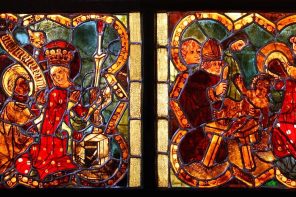“Power is a gift.”[1]
These are not, as you might expect, the words of Frank Underwood, Kevin Spacey’s character in the American version of House of Cards.
Rather, they are the words of Andy Crouch, the executive editor of Christianity Today, who has written widely on the relationship between the Christian faith and culture, and who wants you to come to terms with that simple, counterintuitive idea.
In his most recent book, Playing God: Redeeming the Gift of Power, Crouch challenges the notion that power is simply destructive or corrupting. Rather, he maintains that power is also a gift, and it can and should be used to bring about human flourishing – in short, power can be good news.
Such an opinion swims upstream against our awareness of the abuses of power, which are all too prevalent today and which are summarized all too well by Lord Acton’s famous maxim – “Power tends to corrupt, and absolute power corrupts absolutely.” More importantly, it seems to clash with the beliefs of the Christian faith, which affirms that God humbled Godself by taking on human flesh in Jesus Christ, who died upon a cross for the sake of humanity and who called his disciples to deny themselves, take up their own cross, and follow him (Matt. 16:24).
To be fair, Crouch is certainly aware of the dangers of power. He laments many examples of the exploitation of the powerless by the powerful, which have led to justified anxieties about its misuse. But he also seeks to rehabilitate a biblically informed understanding of power.
As I reflect upon this theme during the season of Lent, when Christians recall Christ’s suffering and sacrificial death, I admittedly feel an internal tension. For Jesus was the obedient Son (Heb. 5:8) and the humble servant, who came to give his life as a ransom for many (Matt. 20:28).
But he was not only that. He was also God incarnate, who fulfilled John the Baptist’s claim that one more powerful than he was coming (Matt. 3:11), which Jesus confirmed by healing the lame, calming the storm, and raising the dead. One could argue, of course, that Christ’s power was demonstrated in his willingness to suffer and die upon the cross. But it is his resurrection from the dead – which Crouch labels “the most audacious act of true power in the history of the world” [2] – that most clearly reveals him to be as much the almighty king as he is the lowly lamb.
Importantly, the biblical dynamics of power do not end with Christ’s demonstration of his own divine authority. For although Christ is the power of God (1 Cor. 1:24), he also promised his disciples that they too would receive power from the Holy Spirit (Acts 1:8), who enabled their ministry and empowered them to spread the gospel, which is itself affirmed as the saving power of God (Rom. 1:16).
In light of this Spirit-led calling to declare the power of God revealed in the crucified and risen Christ, I turn to an arena where the dynamics of power are undeniably at work, but rarely acknowledged – the power of art in the church’s worship.
Neither art nor the church is immune to power, and in both cases it can actually be a gift – though that has not always been so. Art has the power to shape our culture, our imagination, and even our faith, but its power can also be used to promote political propaganda, sexist agendas, or racist attitudes. Likewise, the church’s power may be displayed in its effective declaration of the gospel, its efforts to spread that message throughout the world, and its capacity to combat matters of social injustice, but power can also lead to prideful ministers and divisions within a pastoral staff, congregation, or denomination.
These dynamics of power coalesce when art is employed within the church’s worship. While there have been – and remain – justified concerns about the dangers of idolatry, throughout much of the church’s history, the power of art has been appealed to as a means to communicate the gospel message and enable the worship of God.
For example, one need only think of Gregory the Great’s belief that images can serve as “the books of the unlearned,” John of Damascus’s defence of the veneration of icons in Byzantine worship, or Martin Luther’s rejection of iconoclasm and his appeal to the benefits of art: “I would like to see all the arts, especially music, used in the service of Him who made and gave them.”[3] Even those who have expressed greater reservation with regard to the role of art in Christian worship implicitly acknowledge its power. With regard to music, at least, John Calvin thought that this power could be employed to the church’s advantage: “[I]f the singing be tempered to that gravity which is fitting in the sight of God and the angels, it both lends dignity and grace to sacred actions and has the greatest value in kindling our hearts to a true zeal and eagerness to pray.”[4]
This does not mean, of course, that the power of art has always been used to the church’s benefit. Crouch reflects briefly upon this reality in light of recent trends in contemporary worship: “The granting of the power of amplification to “worship teams” in American Christianity has done more than anything since the Protestant Reformation to undermine congregational song. Once Protestants were known for their lively and joyful corporate singing, but today in many of our largest and most imitated churches the only music worth admiring comes from multithousand-watt sound systems while the vast majority of image bearers in the room sing weakly or not at all.”[5]
The dynamics of power are unavoidable when considering the place of art in the worshiping life of the church. Like most matters in the Christian life, then, the question becomes whether the power of art will be used for God’s glory and our good or whether it will become a divisive and destructive force. Through careful discernment guided by the Holy Spirit, the power of art can proclaim the truth of the one whose power is made perfect in weakness (2 Cor. 12:9), but who is also – in the words of one of the church’s hymns – “perfect in power, in love, and purity.”
[1] Andy Crouch, Playing God: Redeeming the Gift of Power (Downers Grove, IL: IVP Books, 2013), 9. See also Crouch’s earlier book, Culture Making: Recovering Our Creative Calling (Downers Grove, IL: IVP Books, 2008).
[2] Crouch, Playing God, 25.
[3] Martin Luther, “Preface to the Wittenberg Hymnal,” in Luther’s Works, Vol. 53 (Philadelphia: Fortress Press, 1965), 316.
[4] John Calvin, Institutes of the Christian Religion (Philadelphia: The Westminster Press, 1960), 3.20.32, 895.
[5] Crouch, Playing God, 185.
The Rev. Dr. David McNutt (Ph.D., Cambridge; M.Litt, St. Andrews; M.Div., Princeton Theological Seminary; B.A., Pepperdine) is Guest Assistant Professor of Theology at Wheaton College, an ordained minister in the Presbyterian Church (USA), and an Associate Editor at IVP Academic. His written work has appeared in several journals, including the International Journal of Systematic Theology, Religion and the Arts, Cultural Encounters, and Books & Culture online. He greatly enjoyed the three years that he and his wife, Jennifer, spent in St. Andrews, and he particularly misses discussions within the ITIA community and playing golf on the Old Course.




